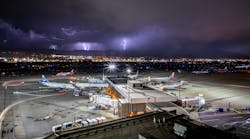National Weather Service (NWS) local Weather Forecast Offices (WFOs) provide routine aviation weather products which are designed specifically for aircraft flight operations – takeoffs, landings and inflight conditions near the airport.
WFOs can also provide Airport Weather Warnings (AWWs) for “weather phenomena, which can adversely impact airport ground operations.” AWWs are provided for “ground decisions” not “in-flight operations.”
To accommodate the variety of terminal circumstances an AWW is issued based on weather criteria specific to each airport. These criteria have been predetermined by mutual agreement between the WFO and the local airport management and are formalized by a Letter of Agreement (LOA). According to National Weather Service Instruction 10-108, published in 2019, the AWW will “include the triggering phenomenon, location, start time (end time as needed) and may include additional remarks.”
AWWs are designed to ensure the safety of passengers, airport personnel and others who may be endangered by weather events. Their issuance also necessitates changes in operations or procedures on the ground. Refueling of aircraft can be halted by a lightning threat. Snow and/or ice will lead to deicing procedures on aircraft. Snow removal may be necessary to complete standard operations. Aircraft and supporting equipment may need to be tied down during high wind events.
The LOA is basically the contract between the WFO and the airport. It establishes the weather elements to be warned for, dissemination mechanisms and points of contact. This LOA may be amended at any time by mutual consent of all parties. It is either specifically stated, or at least implied, that the described weather event may affect not only the immediate airport ground operations but the surrounding area within 5 statute miles of the airport center. The AWW was designed to complement the standard NWS forecasts and warnings. Airport management should continue to refer to these products.
AWWs are issued with as much lead time as possible. This does vary depending on the weather element being dealt with. The actual lead time by element will be determined in advance by agreement of the WFO and airport and this will be reflected in the LOA. Thunderstorm-related warnings typically have a short lead time, hours or even minutes. Major winter storms or tropical cyclones typically can be forecast further in advance and this allows for longer lead times for storm-related issues – at least several hours. The AWW will be updated and canceled when necessary.
Although criteria for an AWW will vary by airport, criteria could include thunderstorm threats such as strong winds, lightning and/or large hail; strong non-thunderstorm winds; heavy snow; and freezing rain. Other elements such as fog, freezing fog or tropical storms/hurricanes can also be included.
The climate of region will determine what weather hazards must be dealt with, and this varies tremendously.
For example, in the weather-active region of central Oklahoma, Will Rogers World Airport (OKC) in Oklahoma City experiences many of the above listed threats. Their LOA includes AWW issuance criteria of thunderstorm winds of 35 knots (sustained or gusts) with a proviso if winds of 60 knots are expected after the initial AWW is issued, it will be updated; ½-inch hail with a proviso if 2-inch hail is expected after the initial AWW is issued, it will be updated; non-thunderstorm sustained winds of 35 knots or gusts to 40 knots; freezing rain, freezing drizzle or sleet; or snow accumulating to 2 inches or more.
It should be noted OKC utilizes a private weather service to provide lightning data, therefore lightning is not included in the AWW criteria. This is typical in regions where thunderstorms are common.
“The goal is a 40-minute lead time before the phenomenon moves/develops within 5 miles of the airport. Ttwo hours for winter precipitation,” says Jim Thrash, operations manager at OKC.
In contrast, for San Diego International Airport-Lindberg Field (SAN) in the benign climate of Southern California, the AWW criteria includes sustained surface winds of 25 knots or greater; wind gusts of 30 knots or greater; lightning within 5 miles of the center runway complex; and any potential hail including size and accumulation (this is very rare). An AWW for wind will include wind direction if possible and any restrictions in visibility due to wind-borne matter. With thunderstorms being uncommon in San Diego, private lightning detection would not be cost effective, so the NWS is relied upon.
Lead times for AWWs at SAN will be no more than 30 minutes before the onset of the event or less depending on the situation, says Dean Robbins, airside operations manager. One exception would be if strong winds are forecast for the overnight period. An AWW could then be issued as much as 12 hours in advance to allow for adequate preparations.
A separate service that the NWS provides SAN is a “heads up” on situations when the ceiling or visibility (C/V) is predicted to drop below minimums. Although this is covered in the terminal aerodrome forecast (TAF), airport management desired a special notification of such conditions for planning purposes.
Although SAN has only one runway, one approach is equipped with an instrument landing system (ILS) and has lower minimums than the opposite direction. If wind conditions permit, some aircraft could still use the runway.
This, of course, would result in significant rescheduling with obvious impacts on ground services. This particular weather advisory is the one most often used at SAN, according to Robbins. And since this is based on TAFs, such warnings can go out hours ahead of the event. Robbins says they are in the process of revising the LOA to add this service.
How do airport managers decide upon the specific weather criteria which will initiate the AWW process at the WFO?
“We decided on 35 knots since we routinely see 25-30 knots sustained here,” explains OKC’s Thrash. “Once you get about 35, things start getting blown around more. As for the snow, 2 inches is more likely to see accumulations on the pavements, versus 1 inch. Once we get accumulations, it can cause greater operational impacts. One other factor, the levels we decided on also tends to reduce the number of AWWs that get issued. It reduces the workload on all of us.”
“As winds increase, it has a lot to do with direction as well,” adds SAN’s Robbins. “If we see a cross wind, we see the risk of containers and equipment that’s not properly chocked or braked being blown out onto the aprons and the ramp.”
As for C/V dropping below minimums, he says, “we start seeing more delays.”
How do airport managers respond to AWWs?
Both OKC and SAN stop refueling operations when nearby lightning is noted.
“For severe (thunder) storms, we would mostly likely use an AWW to initiate an evacuation of passengers from the terminal,” says Thrash. “We would also get ATC to issue a ground stop and/or divert airborne aircraft away from OKC.”
“Airlines will determine if they need to bring staff inside,” points out Robbins.
“For winter weather, an alert that frozen precip is expected in the next 2-4 hours would initiate a recall of maintenance staff for snow removal operations – if we haven’t already started that process,” says Thrash.
“For winds, we send out an informational notice reminding everybody to make sure all of their equipment is properly secured and even in the terminals, make sure you’re closing doors,” Robbins says.
As for the C/V issues at SAN, Robbins says about the advanced warnings, “From a planning perspective we can get ready for these types of events.”
Also stated in the LOA is the communications process – who at the airport should receive a phone call, etc. For OKC, calls go out to the operations officer, airport police and the FAA academy duty officer. Once the appropriate airport officials are notified, it is their responsibility to relay the information to those who need to take precautionary actions.
For SAN, an automated email message will be sent to airport operations managers and a phone call will go to the director of airport operations.
The issuing WFO is required to verify all AWWs. Summaries of these verifications are done four times a year. For example, the WFO at Norman, Okla., issued a total of 42 AWWs for OKC in 2018 and 2019. June had the most with 10, while zero were recorded in September and October. Severe thunderstorms accounted for 19 AWWs, winter precipitation nine, general thunderstorms seven and non-thunderstorm winds seven.
By NWS definition, a “severe” thunderstorm has winds of at least 50 knots and/or hail of at least 1-inch in diameter. A thunderstorm with winds of 35 knots and/or hail of ½-inch is defined as “approaching severe.”
In contrast for the past three fiscal years, running October through September, the WFO in San Diego has only issued 12 AWWs for strong winds, seven for lightning and zero for hail. There has been one already in 2020.
Doug Harris, an operations manager at Salt Lake City International Airport (SLC), says they have taken a different path to get their weather information. They have contracted with a private meteorology firm, Weathernet.
“They are more accurate and more airport specific (than the NWS),” Harris says.
Typical of a private company, Weathernet can tailor products for a specific client. For SLC, this starts with a daily general forecast. Unscheduled briefings are utilized when a significant event like a winter storm is forecast. Weathernet also provides alerts, which are comparable to the NWS AWWs.
For SLC, an alert is issued if sustained winds exceed 20 knots; if lightning is observed within 5 miles of the airport; if a severe thunderstorm or tornado warning has been issued by the NWS; or if any “adverse winter weather” is currently expected if it had not been in the forecast or had been under-forecast.
If any of these occur, calls will either be made to the Airport Control Center or Airport Operations.
“We are staffed 24/7/365 and can be contacted for weather support by airport personnel any time,” explains Scott Jensen, operations manager with Weathernet.
Weathernet provides one or more of the above services to dozens of airports around the country.
AWWs are normally provided to “select larger airports.” However, any airport can request an AWW agreement with their local WFO. The WFO will determine the feasibility of such an agreement based on resources and particulars of the situation.
“With the weather tools we have available online, TV, etc., the AWW really helps us confirm that what we think is about to happen is about to happen,” OKC’s Thrash says.
“It’s amazing what the nuances of weather will do to an airport,” concludes SAN’s Robbins.
About the Author

Ed Brotak
Ed Brotak is a retired meteorology professor, turned freelance writer. He specializes in aviation weather hazards and has written dozens of articles on this topic.
